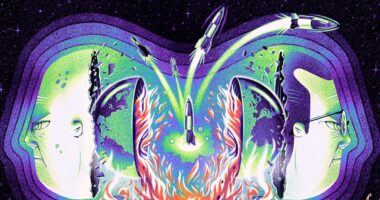A HARVARD professor has claimed a mysterious space object that flashed past Earth in 2017 is evidence of intelligent alien life.
Avi Loeb, Harvard’s Department of Astronomy chair, believes the cigar-shaped blob was space trash dumped by extra-terrestrials over our planet.
Most scientists believe the object, known as Oumuamu, was an asteroid or comet flung in our direction from a distant star system.
Loeb suggested Oumuamu was alien technology as it made its close approach at 196,000mph, though the theory was rubbished by academics.
In an interview last week, the 59-year-old doubled down on his claims, arguing the cigar-shaped mass could have been a spacecraft.
“At first, astronomers assumed it must be a comet, because these are the objects that are most loosely bound to stars,” he told Salon.
“The problem with that was there was no cometary tail.”
Loeb wrote a book on the topic, “Extraterrestrial: The First Sign of Intelligent Life Beyond Earth,” that’s out next week.
Speaking to Salon, he laid out a case for why Oumuamu might be proof that life outside Earth exists.
An additional blitz of force exhibited by the object, which he called an “excess push”, mimics those displayed by our own space tech, he said.
“Some people say, ‘OK it’s not a comet, maybe it’s just a rock’,” Loeb continued.
“But the problem is, about half a year later, it was reported that there was an excess push in addition to the force of gravity acting on it by the sun.
“It exhibited some additional force. Usually that force comes from the rocket effect of the cometary tail, but there was no cometary tail. So the question was, what produces this excess push?”
Loeb highlighted that another space object, this one discovered last year, exhibited a similar “excess push”.
Called 2020-SO, it ended up being a rocket booster from a failed mission of lunar lander, Surveyor II that was launched in 1966.
Loeb said that because 2020-SO was artificially made and had no cometary trail, it “provides evidence” that we can tell the difference between a rock and an object — like the rocket booster — that is pushed by sunlight.
“To me, it demonstrated the case that perhaps ‘Oumuamua was artificial, definitely not made by us because it’s been only a few months close to us. We couldn’t even chase it with our best rockets,” he told Salon.
Loeb added that it was on the “shinier end of all the objects we have seen from the solar system.”
On September 6, 2017, an object from Vega – a nearby star about 25 light-years away – shot past Earth only to move closer to the sun on September 9.
By the end of the month, it flew by Venus at a rate of 58,900 miles per hour.
It then came close to Earth again on October 7 before it began “moving swiftly toward the constellation Pegasus and the blackness beyond,” Loeb wrote in his book.
The Panoramic Survey Telescope and Rapid Response System (Pan-STARRS) in a Hawaiian observatory first spotted the object using the Pan-STARRS most well-defined telescope on earth.
There, the object was monikered “Oumuamua” (pronounced “oh-moo-ah-moo-ah”), which is Hawaiian for “scout.”
Although the object was just a small, 100-yard-long anomaly, those in the scientific community looked to it as a learning point.
It was the the first interstellar object ever detected inside our solar system, and given its trajectory, some astronomers have declared it was not bound by the sun’s gravitational pull.
Although no clear photos of the object were taken, observatories trained their telescopes on the object for almost two weeks, allowing data to be collected that denied a simple explanation of just another comet.
“What would happen if a caveman saw a cellphone?” Loeb asks in his book. “He’s seen rocks all his life, and he would have thought it was just a shiny rock.”
Loeb takes fault with some astronomers claiming the object was a comet, saying it was akin to letting “the familiar to define what we might discover.”
He says astronomers began looking at the object’s dimensions, and the fact that it reflected sunlight at a similar brightness every eight hours, suggesting that was how long it needed to complete a full rotation.
Astronomers said the object was about five to ten times longer than it was wide, relating it to a sort of cigar shape.
Loeb says no natural space object looks like that.
However, the notion that life outside earth exists is seen as a taboo in the scientific community.
“Some people do not want to discuss the possibility that there are other civilizations out there,” he ended.
In other news, a treasure trove of declassified CIA documents about UFOs and alien “encounters” was published online last week.
A researcher claimed last year that the discovery of alien life was not only “inevitable” but also “imminent”.
One Nasa scientist has admitted it’s entirely possible that aliens have already visited Earth – and we simply never noticed.
What do you make of Professor Loeb’s theory? Let us know in the comments!
We pay for your stories! Do you have a story for The Sun Online Tech & Science team? Email us at [email protected]
This post first appeared on Thesun.co.uk
























